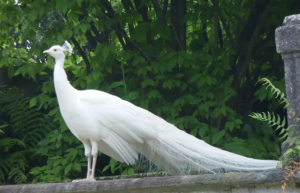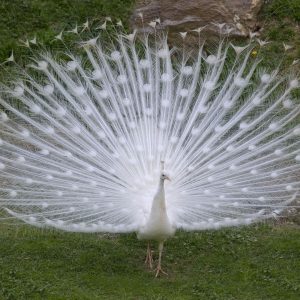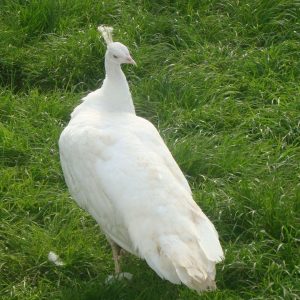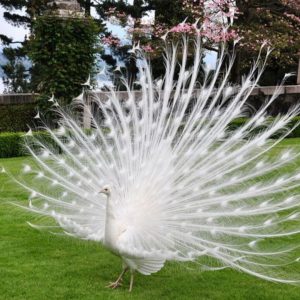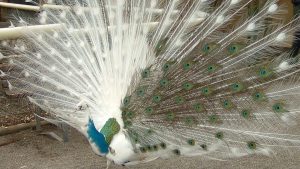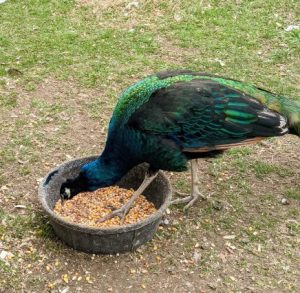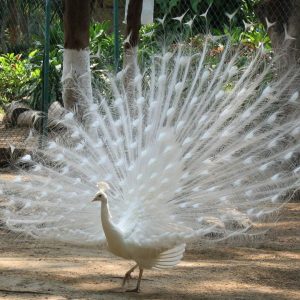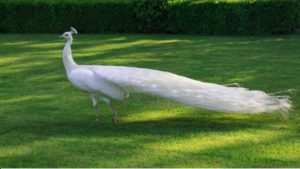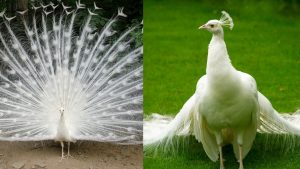Females White Peacock have white bellies, while males’ bellies are the same blue as the rest of their plumage. Although males look far more attractive, females have the advantage in the wild. As it is easier for them to camouflage themselves and avoid predation. In this page we talk about Female White Peacock | Peafowl Life and Their Facts.
Contents
White Peacock:
The White Peafowl is a rare and beautiful sight and this white peacock with around 150 feathers. That extended is sure to be noticed. White peafowls are Indian Blue Peafowls with a rare genetic mutation called leucism.
There are white peacocks and now there’s video. White peacocks are not albinos. They actually have a genetic mutation that is known as Leucism. That causes is the lack of pigments in the plumage. A white peacock is technically a genetic variant of the Indian Blue Peafowl.
The White Peacock symbolizes the Divine self realize, purify and clean the illuminated soul self. As if witnessing itself being born again the Divine self is resurrecte from fire of fear and shadows of doubt. In this page we talk about Female White Peacock.
The white peacock is a variation of the blue peacock native to the Indian subcontinent. But now bred in captivity around the world. Of course, it’s important to distinguish that when we refer to peacocks, we’re technically speaking about a male peafowl. Females are called peahens while babies are called peachicks.
Female White Peacock:
When compared to females, males are taller and longer. Usually, small-sized female peacocks weigh much less than the males. While adult males have a body weight that ranges between nine and thirteen pounds, females weigh around six to nine pounds. An adult male can be as long as 7.5 feet (including the tail), whereas an adult female is around 2.5 to 3.5 feet in length.
Their feathers tend to be either brown, gray or cream in color. Females have white bellies, while males’ bellies are the same blue as the rest of their plumage. Although males look far more attractive, females have the advantage in the wild, as it’s easier for them to camouflage themselves and avoid predation.
If White peacocks are bred to white peahens all of their chicks will be white. These lovely birds have all come to be known as Peacocks. But the correct name of this species of bird is peafowl. It is the male that is refer to as a Peacock and females as peahens.
The baby peafowl are called peachicks. But one rare type of peacock makes a spectacle even without all the bold color. The white peacock is a variation of the blue peacock native to the Indian subcontinent, but is now bred in captivity around the world. White peafowl have a genetic mutation called leucism.
Male White Peacock:
White Peacock or Peafowl is common name for three bird species in genera Pavo and Afro-pavo of family Phasianidae, pheasants and their allies. Male peafowl referred to as Peacocks and female peafowl referred to as peahens. Even though peafowl of either sex are often referred to colloquially as “peacocks”.
The White Peacock is just as lovely in beauty. Its feathers and appearance is nearly exactly same as its colorful counterpart except its feathers are white. The White Peacock fans out its white train to display its feathers, revealing cloud of white magnificence. The all white color of peacock is trait of beauty among species of beautiful birds. A white version of an animal can be found in nearly any species.
The white peacock is a variation of the blue peacock native to the Indian subcontinent, but is now bred in captivity around the world. Of course, it’s important to distinguish that when we refer to peacocks, we’re technically speaking about a male peafowl. White peafowl have a genetic mutation called leucism.
Whomever you come across in India, be it on the shores of Chennai, or around the narrow alleys of Chandi Chowk, or even deep within the snow capped mountains of the Himalayas, all will be able to recognize the peacock. They tend to run and take several small leaps before a big final hop. They can’t stay airborne for very long, but their huge wingspan allows them to flutter quite far.
Are There White Peacocks?
There are white peacocks that are white due to a condition called Leucism. Leucism is a variety of conditions that cause the partial loss of pigmentation in an animal.
Leucism can affect the skin, hair, feathers, or scales of the animal and can cause white, pale, or patchy coloration but does not affect the eyes. In this page we talk about Female White Peacock.
White peacocks are a rare form of the blue peacock which has the genetic mutation causing Leucism. White peacocks are born yellow and turn white as they mature. Pied peacocks have partial leucism and so have patches of color loss.
Are There Albino Peacocks?
Yes, there are albino peacocks but these are very rare, much rarer than white peacocks. In fact, you are usually seeing a white peacock rather than an albino peacock as although the feathers are white, the eyes are not red and so the animal has leucism rather than being a true albino.
Albino peacocks would have a complete lack of melanin which would also result in red eyes. Melanin is a group of natural pigments that are produce by most organism. It is responsible for determining skin, hair or feather colors.
Peacock colors:
Peacocks can be found in a wide variety of colors including white, purple, opal, cameo, peach, bronze, charcoal, jade, taupe and midnight. Occasionally peacocks can appear white. In this page we talk about Female White Peacock.
According to Wikipedia, there are several hundred variations in color and pattern recognized as separate morphs of the Indian Blue Peafowl among breeders. Pattern variations include solid wing color, pied which is where the color is not complete across the bird and white-eyed where the ‘eye’ feathers are white instead of black.
The bright iridescent colors of the Peacocks’ feathers are not due to pigments but are actually due to structural changes that scatter light and produce amazing colors. According to a scientific study, peacocks will orient themselves towards the sun for the ‘train-rattling’ display to enhance the appearance of the feathers.
Peacock Food:
One the favorite foods of peafowl is insects. Peacocks are not picky and will readily consume ants, flying insects, grubs or almost any other bug. Place a handful of mixed fruits and vegetables, including foods such as green beans, corn, chopped carrots, berries and shredded leafy greens, in with your peafowls’ evening food.
Peacocks also eat cat food, cheese, nuts, scrambled eggs, cooked rice, grains and kitchen scraps. It is important to feed peafowl a high protein diet to maintain optimum health. Do not feed your peacocks Basic Poultry Layers Pellets or Mixed Corn.
Peacocks, like other birds, only ever need to drink water. Birds that consume vast quantities of insects or other water rich foods don’t need to drink much, if at all. Peacocks are quite large birds, though, so they will need their own clean water supply as they won’t stay adequately hydrated from their food alone. Peafowl can use their senses and fast speed to locate and catch small fish in shallow waters.
How rare are white peacocks?
Although rare, white peacocks can be bred from other white peacocks. They will produce white peachicks if bred in captivity. So white peacocks can easily be bred to produce white offspring. In this page we talk about Female White Peacock.
They would not be common in the wild naturally as the genetic mutation is very rare so white peacocks would breed with the natural blue colored peacocks which would not usually produce white offspring.
Where are White Peacocks Found?
White peacocks are usually bred for their white coloring and therefore can be found all over the world. A white peacock is a form of blue peacock originally from India.
There are three species of peacocks (peafowl) which all have different dominant coloring:
- Indian Peafowl is bluer in coloring.
- Green Peafowl from Southeast Asia, which is more green in coloring
- Congo peafowl which is more black and brown for the male and green and brown females
The natural habitat of peacocks is woodland and forest but they adapt well to different environments and captivity. They found in India and Sri Lanka and Southeast Asia and also in Congo Basin.
Peafowl is the correct name for both the male and female peacocks. But they often both get referred to as peacocks. Female peafowl are called Peahens. Peahens do not have elaborate tail feathers and are not as colorful as the male peacock.
What Does a White Peacock Symbolize?
Peacocks hold a lot of different symbolism for different religions. Peacocks in general hold a lot of symbolism rather than the white peacock itself. In this page we talk about Female White Peacock.
The peacock is the national bird of India and represents the succession of temporal cycles in Hindu cosmology. In Hinduism, the peacock created from one of the feathers of the mythical bird Garuda. That was a huge majestic bird with carried lord Vishu on its back. Peacocks feature heavily in the Hindu religious beliefs.
In Persia and Babylonia, the peacock seen as a guardian to royalty. The Yazidi consider Melek Taus the “peacock angel” and is a central figure of their faith as a benevolent angel and an emulation of God.
In ancient Greece, the peacock was a symbol of immortality as they believed the flesh of the peafowl does not decay after death. In Christianity, the eyes in the peacock feathers symbolize the all seeing Christian God.
Are White Peacocks Lucky?
All peacocks are consider lucky in some countries. In India, the peacock feathers are believe to bring prosperity in Hinduism.
In China, the peacock is consider a good omen that was able to ward off evil spirits.
Difference Between Male and Female Peacock:
Although the term “Peacock” often used to refer to males and females. True name of the species is the Indian Peafowl or Pavo Cristatus. Males are known as Peacocks and females as Peahens. As their name suggests, they are native to India but also live naturally in surrounding countries. In other parts of the world, they are more commonly kept as ornamental birds.
The most obvious difference between male and female Indian peafowl is their coloration. Males are usually an iridescent shade of bright blue. This bold coloration helps them to attract mates. On the other hand, Peacock have much more subdued plumage. Their feathers tend to be either brown, gray or cream in color. Females have white bellies, while males’ bellies are the same blue as the rest of their plumage.
Another gender difference when it comes to Indian peafowl is size. Measuring in at between 3 and 4 1/2 feet long and weighing between 9 and 13 pounds. Males are significantly larger than their female counterparts. Peahens tend to measure between 2 1/2 and 3 1/2 feet long and weigh between 6 and 9 pounds.
One important difference between male and female Indian peafowl by looking at their behavior. Females can become aggressive when it’s time to mate, fighting with other females for best male specimens. Only female peafowl build nests and incubate the eggs with males showing no parental involvement at all. In the wild, both males and females can live in small groups or alone but males are more likely to be solitary.
Conclusion:
White peafowls are Indian Blue Peafowls with a rare genetic mutation called leucism. The white peacock is a variation of the blue peacock native to the Indian subcontinent. But is now bred in captivity around the world. Usually, small-sized female peacocks weigh much less than the males. Females have white bellies while males’ bellies are the same blue as the rest of their plumage.
